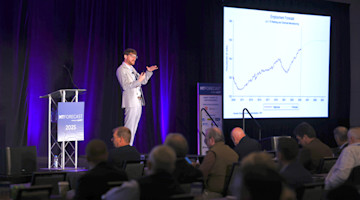McLean, Va. (February 13, 2025) — Shipments of cutting tools, measured by the Cutting Tool Market Report compiled in a collaboration between AMT – The Association For Manufacturing Technology and the U.S. Cutting Tool Institute (USCTI), totaled $179.5 million in December 2024. Orders decreased 2% from November 2024 and were down 4.3% from December 2023. Shipments totaled $2.43 billion for 2024, down 0.6% from shipments made in 2023. The year-to-date growth rate declined every month in 2024 beginning in April.
“Our industry continued to feel the effects of a stagnated aerospace market as we ended 2024, and this sets us up for a rather uneven first and second quarter,” stated Steve Boyer, president of USCTI. “Cutting tool markets still tended to perform better than other markets through the end of 2024 and start of 2025 but have noticeably softened. Adjusted lower outlooks for this year in the transportation, automotive, aerospace, and defense sectors will project a slower rebound.”
Alan Richter, editor-at-large of Cutting Tool Engineering, added: “With economic and market uncertainties, such as tariffs, supply chains, and inflation, coupled with ongoing and new geopolitical tensions swirling with the election of a new U.S. presidential administration, manufacturers that use cutting tools continued to decrease their tool consumption in December, albeit at a slower rate than November. However, more encouraging reasons for the slide include toolmakers developing cutters that last longer while running at higher machining parameters, productivity gains with automation and AI, and increased efficiency from implementing advanced, or ‘smart,’ technologies.”
The Cutting Tool Market Report is jointly compiled by AMT and USCTI, two trade associations representing the development, production, and distribution of cutting tool technology and products. It provides a monthly statement on U.S. manufacturers’ consumption of the primary consumable in the manufacturing process, the cutting tool. Analysis of cutting tool consumption is a leading indicator of both upturns and downturns in U.S. manufacturing activity, as it is a true measure of actual production levels.


# # #
AMT – The Association For Manufacturing Technology represents and promotes U.S.-based manufacturing technology and its members – those who design, build, sell, and service the continuously evolving technology that lies at the heart of manufacturing. Founded in 1902 and based in Virginia, the association specializes in providing targeted business assistance, extensive global support, and business intelligence systems and analysis. AMT is the voice that communicates the importance of policies and programs that encourage research and innovation, and the development of educational initiatives to create tomorrow’s Smartforce. AMT owns and manages IMTS – The International Manufacturing Technology Show, which is the premier manufacturing technology event in North America.
The United States Cutting Tool Institute (USCTI) was formed in 1988 and resulted from a merger of the two national associations representing the cutting tool manufacturing industry. USCTI works to represent, promote, and expand the U.S. cutting tool industry and to promote the benefits of buying American-made cutting tools manufactured by its members. The Institute recently expanded its by-laws to include any North American manufacturer and/or remanufacturer of cutting tools, as well as post-fabrication tool surface treatment providers. Members, which number over 80, belong to seven product divisions: Carbide Tooling, Drill & Reamer, Milling Cutter, PCD & PCBN, Tap & Die, Tool Holder and All Other Tooling. A wide range of activities includes a comprehensive statistics program, human resources surveys and forums, development of product specifications and standards, and semi-annual meetings to share ideas and receive information on key industry trends.
# # #






